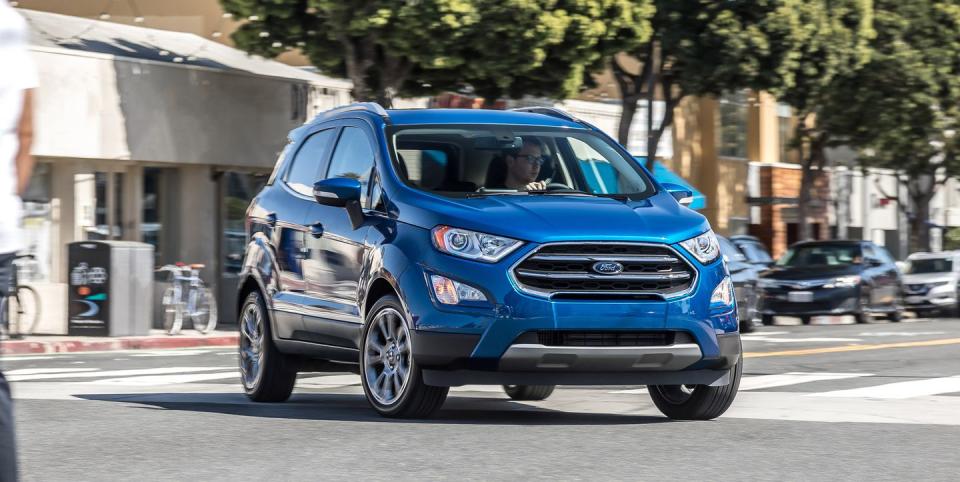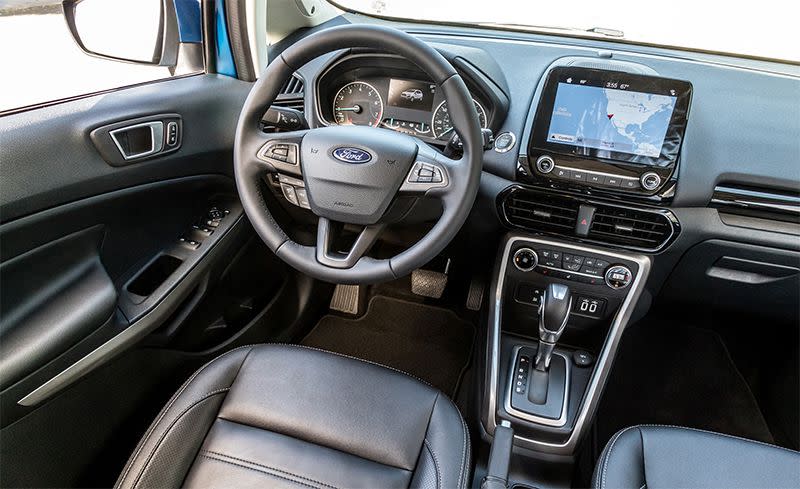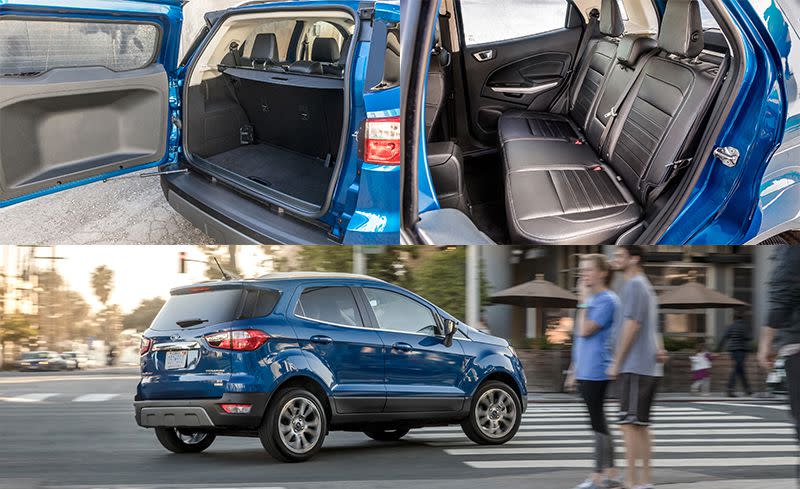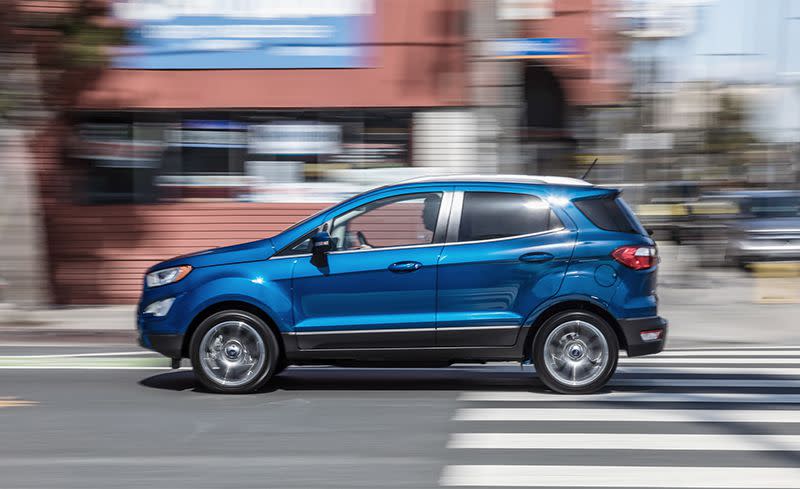2018 Ford EcoSport Tested: Is There an Eco in Here?

From the June 2018 issue
Screwy language plagues the auto industry. “Titanium” and “Platinum” are no indication of the presence of those metals, “Limited” means unlimited sales, “coupes” often have four doors, “sport” has nothing to do with competition, and no collector buys a “Collector’s Edition.” But of all the whacked, dopey, lazily overused terms, nothing beats “Eco.” There’s Ecotec, EcoDiesel, Eco Assist, and Eco Mode, and a forest of green buttons in new vehicles marked simply “Eco.” Now here comes Ford’s new 2018 twerp-class crossover as the alpha dog of eco-for this story, we tested a front-drive EcoSport Titanium, powered by a 123-hp 1.0-liter inline-three EcoBoost engine and riding on Bridgestone Ecopia EP422 Plus tires. A 166-hp naturally aspirated 2.0-liter inline-four is also available, paired exclusively with all-wheel drive.
The EcoSport isn’t that new. The name first appeared on a Fiesta-based, Brazil-built SUV that made its debut for the 2004 model year, and this second-generation model went on sale in 2012 as a 2013. Ford actually produces EcoSports in six countries-Brazil, China, India, Romania, Russia, and Thailand-and sells them virtually everywhere. The United States is a latecomer to this EcoParty and is getting its EcoSport fix from Ford’s plant outside Chennai, India. This is, as far as anyone here can figure, the first new production vehicle assembled in India and exported to the U. S. That said, the turbocharged iron-block three-cylinder engine comes from a plant in Cologne, Germany, the six-speed automatic transmission is made in Mexico, and this dinky SUVish thing is built atop Ford’s global B-car platform developed across Europe, including, presumably, at the top-secret Worldwide Engineering Excellence facility (WEE) in Lilliput.
This EcoSport looks like an Escape that’s been shriveled down in a dehydrator. At 161.3 inches long overall, it is 16.8 inches shorter than an Escape, a staggering 37 inches briefer than an Explorer, and more than five feet shorter than an Expedition Max. The Mazda CX-3 is no giant, but it comes in seven inches longer than the Ford. The EcoSport is, however, 1.6 inches lengthier than its engineering littermate, the Fiesta hatchback, and its 99.2-inch wheelbase is 1.2 inches greater than that car’s. With its wheels pushed out to the corners, the EcoSport embodies the efficiencies Alec Issigonis exploited so well with the original Mini. And with its tall greenhouse and upright seating, the EcoSport accommodates four in fair enough comfort as long as the front passengers are willing to keep their seats scooted forward. But five? Going three across in the rear with only 51.3 inches of shoulder- and 50.9 inches of hiproom demands a crushing intimacy. That center seatbelt is just a tease.
And cramming even four people into such a compact box doesn’t leave much room for anything else. The 21 cubic feet behind the second row is 13 cubes less than what the Escape provides and about three behind that of a front-drive Honda HR-V. With that in mind, the space is almost rectangular and accommodating. And when the 60/40 split second-row seat is folded forward, the resulting 50 cubic feet is usable, though hardly cavernous. Pack light. Exercise restraint at Costco.
The EcoBoost three doesn’t hum as much as it trills. There’s a vibrato to its voice that’s somehow engaging. But a single liter can make only so much power-even with a turbocharger. And there’s only so much that horsepower can do to spur 3146 pounds of ute. Pin the throttle and the speedometer’s needle rises so slowly it knits a sweater before hitting 60 mph. That’s 10.4 seconds of your life gone, but good turtlenecks take time. It makes the barely more expensive turbocharged Kia Soul, which hits 60 in 6.3 seconds, seem socially irresponsible. But even the lethargic front-drive Chevy Trax manages a 9.3-second sprint. The Ford’s quarter-mile goes by in 17.9 seconds, so you can get mittens, too. It takes a dilatory 39.1 seconds for the EcoSport to reach 100 mph. That’s a whole afghan. So the EcoSport isn’t quick, but that’s not a fair measure of how well the three-cylinder works in normal use. Ford tuned this engine so that the turbo comes on early and sustains its torque production without the need to go wide open. It’s fine as a city car, but you’ll want to avoid any taxing freeway moves. During cruise, the three drops out of boost and relaxes. But even in a crosswind, the EcoSport bucks against the additional resistance, the turbo returns to work, and the six-speed automatic transmission kicks down a gear. Our test car returned just 24 mpg, considerably short of its EPA-estimated 28 mpg combined. Both the Honda HR-V and Mazda CX-3 are rated at 31 mpg combined.
Sized 205/50R-17, those Ecopia all-season tires aren’t exactly sticky. The EcoSport’s steering is satisfyingly responsive, but the limit-0.80 g on the skidpad-is low. Combine that with the limited power and a somnambulant transmission-even when manually shifted-and this isn’t a machine for hunting out entertaining back roads. It’s an urban tool. The stiff ride that’s acceptable in short bursts becomes fatiguing on long trips, and there’s an annoying increase in wind noise as the EcoSport approaches 80.
The EcoSport (pronounced echo-sport) is a good home for the EcoBoost (eek-o-boost) three, as long as it’s driven within its modest brief. Along the crowded streets of Rio, Mumbai, Bucharest, or Moscow, that might be easy. But America’s wide-open spaces aren’t the right milieu for the EcoSport. It breaks with the Eco theme, but the more powerful all-wheel-drive version is better suited to North America. Ford hides the trigger to open the EcoSport’s left-hinged, side-opening rear door on the right taillight.
It’s fun watching your kids’ frustration as they look for it. The tiny ute needs more delightful elements like that-in addition to segment-competitive performance and fuel economy-to help the EcoSport hit the EcoSpot.
You Might Also Like

 Yahoo Autos
Yahoo Autos 


